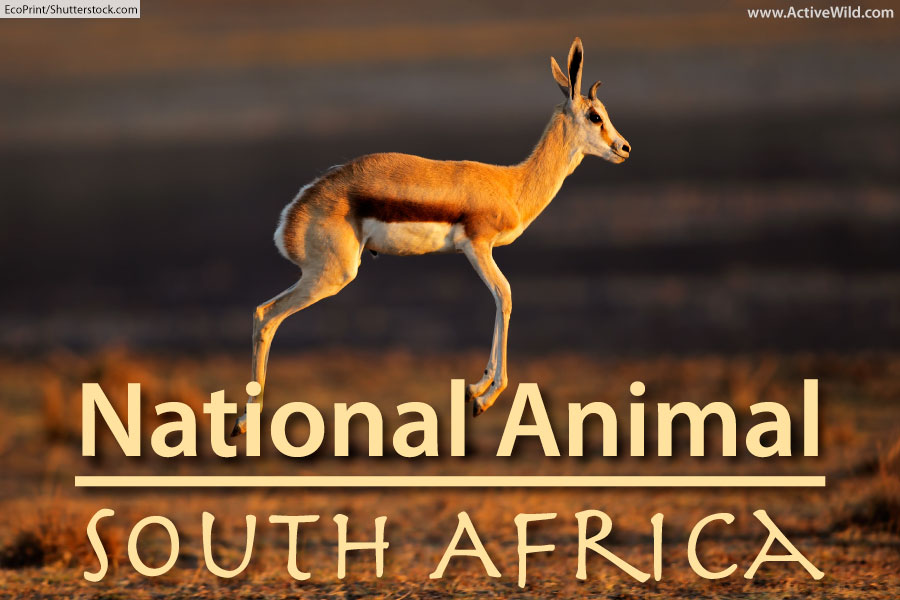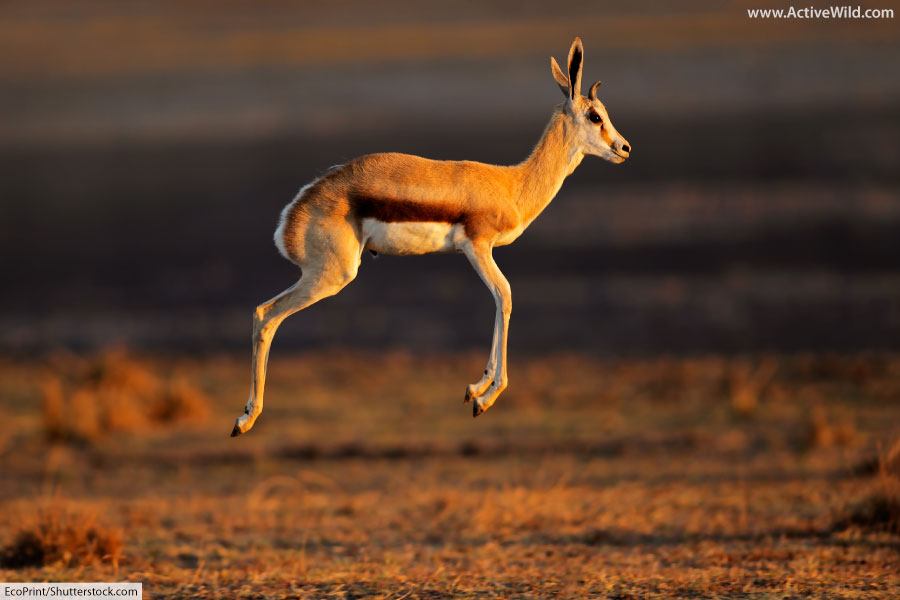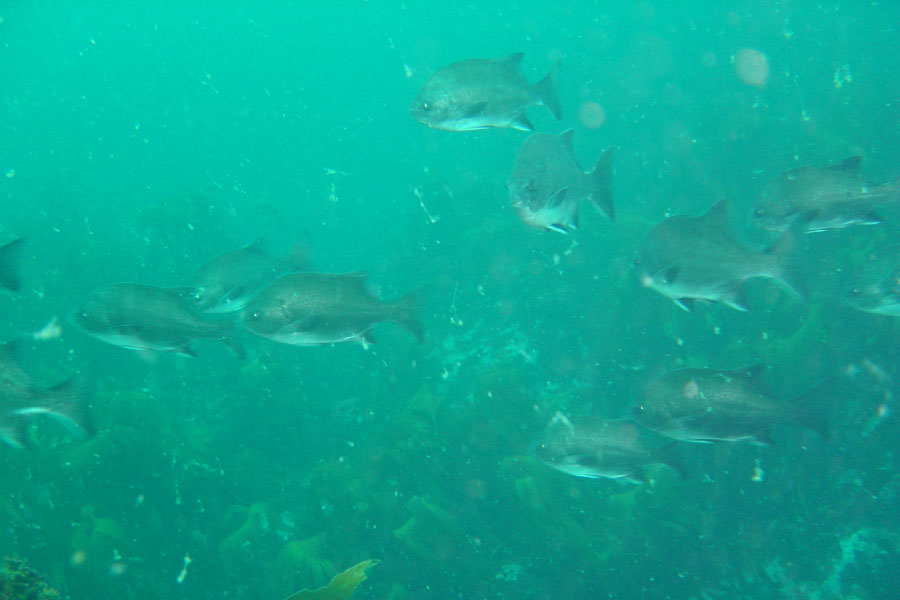On this page we take a look at the springbok, the national animal of South Africa, and also discover other South African national animals and plants.
National Animal of South Africa
The national animal of South Africa is the springbok, a medium-sized antelope found in South Africa and other countries in southern Africa. It is known for its ‘pronking’ display, in which the animal repeatedly jumps vertically into the air while showing its white rump. The springbok has an adult population of around 1.5 million and is rated ‘Least Concern’ by the IUCN.
On this page you'll find out more about the springbok, together with other animals and plants that are symbols of South Africa. Continue reading to discover all of the country's national symbols, or click on an item in the list below for information about a particular species.
Page Index
- The National Symbols of South Africa
- Introduction to South Africa
- Springbok (National Animal of South Africa)
- Blue Crane (National Bird of South Africa)
- Galjoen (National Fish of South Africa)
- King Protea (National Flower of South Africa)
- Real Yellowwood (National Tree of South Africa)
- Plants and Animals on the South Africa Coat of Arms
- Find out more about African Wildlife
The National Symbols of South Africa
- National Animal of South Africa: Springbok (Antidorcas marsupialis)
- National Bird of South Africa: Blue Crane (Anthropoides paradisia)
- National Fish of South Africa: Galjoen (Dichistius capensis)
- National Flower of South Africa: King Protea (Protea cynaroides)
- National Tree of South Africa: Real Yellowwood (Podocarpus latifolius)
South Africa
South Africa is the southernmost country of the continent of Africa. With an area of 1,221,037 km2 (471,445 sq. mi.), it is the ninth-largest country in Africa and the twenty-fourth-largest country in the world.
South Africa is home to many of Africa’s most famous animals, including lions, leopards, cheetahs, wildebeest, rhinos, hippos, giraffes and elephants.
- You can see more African animals on this page: African Animals with Pictures and Facts.
As well as being of global importance to conservationists, South Africa’s wildlife is a major tourist attraction. People flock from all over the world to see Africa’s iconic animals and tourism is a major contributor to the country’s economy.
South African National Animals And Plants
National Animal of South Africa: Springbok (Antidorcas marsupialis)
The national animal of South Africa is the springbok (scientific name Antidorcas marsupialis). The springbok is a medium-sized antelope. It is found not just in South Africa, but also in several other southern African countries, including Angola, Botswana and Namibia. The species is typically found in grassland and savanna habitats, but may also be found in shrubland and desert.
The springbok has a conservation rating of Least Concern and its population is currently thought to be increasing.
With a shoulder height of around 80cm and weighing from 37 kg (ewes) to 50 kg (rams), the springbok is a slender, agile antelope. It is capable of running at speeds of up to 88 km/h (55 mph).
Distinctive characteristics of the springbok include: white face with black stripe running from each eye to the corner of the mouth; pale brown neck, shoulders and back; wide, dark chestnut brown stripe along the flanks and white underparts.
Both sexes have ridged, pincer-shaped horns which are between 35 - 50 cm (14 - 20 in) in length.
Running from the middle of the springbok’s back to its rump is a fold of skin which when opened reveals a striking white patch of hair. The springbok opens this flap when excited or nervous.
Another behaviour exhibited by the springbok is ‘pronking’. Pronking involves the animal making a series of vertical leaps with its back arched, its head pointing down and its white rump hair exposed. This behaviour may help to deter predators or to warn the rest of the herd that a predator is in the vicinity. It may also be used as a display.
The springbok was first used as a symbol of South Africa in 1906, when the South Africa rugby team toured Britain, Ireland and France.
It is said that South Africa’s then captain, Paul Roos (Wikipedia), together with tour manager Cecil Carden and vice-captain Paddy Carolin, came up with the nickname to prevent the English press inventing one of their own.
National Bird of South Africa: Blue Crane (Anthropoides paradisia)
Like all cranes, the blue crane has long legs and a long neck and flies with a straight, rather than a bent, neck. This tall bird reaches a height of around 1.2 m (4 ft.) and has a wingspan of up to 2 m (6.5 ft.).
As its name suggests, the blue crane is blue-grey in colour. Its tail feathers and wingtips are dark grey or black. The species’ scientific name, Anthropoides paradisia, may refer to the species’ pale blue, ‘angelic’ appearance.
The blue crane is found in grasslands and wetlands. It is nomadic, or partially migratory, and only congregates in large numbers during the breeding season.
The conservation status of South Africa’s national bird is ‘Vulnerable’. The species is suffering as a result of habitat loss due to housing and urban development and the planting of commercial forests in its grassland habitat.
National Fish of South Africa: Galjoen (Dichistius capensis)
The galjoen has a round, thin, saucer-like body and can reach 80 cm 31.5 in. in length. It is silver-grey in colour. Its fins have a number of spines. The species’ diet consists of seaweed and small marine animals such as sea squirts, shellfish and barnacles.
Due to overfishing the galjoen is now listed as Red by SASSI (Southern African Sustainable Seafood Initiative). There is a limit on how many galjoen may be caught by recreational anglers, who are also banned from selling any galjoen they catch.
The galjoen was suggested as a national fish by Margaret Smith, wife of South African ichthyologist (fish scientist) J. L. B. Smith.
National Flower of South Africa: King Protea (Protea cynaroides)
The king protea, also known as the giant protea (scientific name Protea cynaroides), is the national flower of South Africa. It is a 2m (6.6 ft.) tall woody, evergreen shrub with thick stems. Its large, glossy leaves are dark green in colour.
The ‘flower’ of the king protea is in fact an inflorescence – a collection of many small flowers – in one bowl-shaped head of diameter 12 to 30 cm (5 to 12 in.). Surrounding the pink / white head are petal-like leaves known as bracts which are darker pink in colour.
The king protea grows naturally in southern South Africa, particularly in Fynbos region located in the Western Cape and Eastern Cape provinces of South Africa.
National Tree of South Africa: Real Yellowwood (Podocarpus latifolius)
The national tree of South Africa is the real yellowwood (scientific name Podocarpus latifolius), also known as the broad-leaved yellowwood.
The real yellowwood is a large conifer (cone-producing tree). The species can grow up to 35m in height with a trunk up to 3 m in diameter, but also appears as a shrub under 2m high. Its conservation status is Least Concern and the species is protected in South Africa.
The bark of the real yellowwood is grey in colour and develops fissures as the tree ages. The leaves are long, glossy and green in colour. The species either grows tall and straight, or low and spread out.
Animals on the South Africa Coat of Arms
Unsurprisingly for a country famous for its animal life, animals and plants are well-represented on the South African coat of arms.
At the top of the coat of arms is a secretary bird with its wings outstretched. The species is a mainly terrestrial (land-dwelling) bird of prey, famous for its ability to capture and eat snakes.
The king protea, national plant of South Africa, is also featured on the coat of arms, as are two ears of wheat.
Surrounding the lower part of the coat of arms are two pairs of elephant tusks.
National Animal of South Africa: Discover More
- Discover more amazing African animals on this page: African Animals List with Pictures and Facts
- Find out which crocodiles live in Africa: African Crocodiles List with Pictures and Facts
- See more African reptiles here: African Reptiles List








